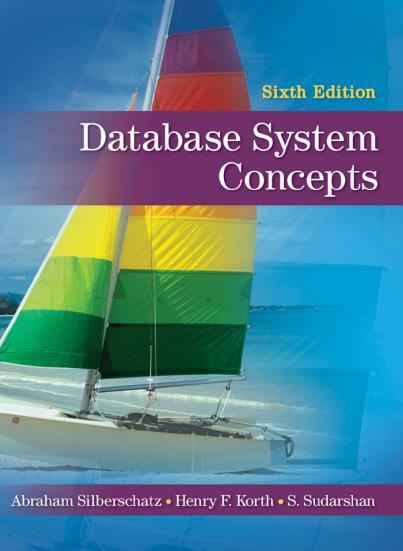
Sixth Edition Database System Concepts Abraham Silberschatz.Henry F.Korth.S.Sudarshan
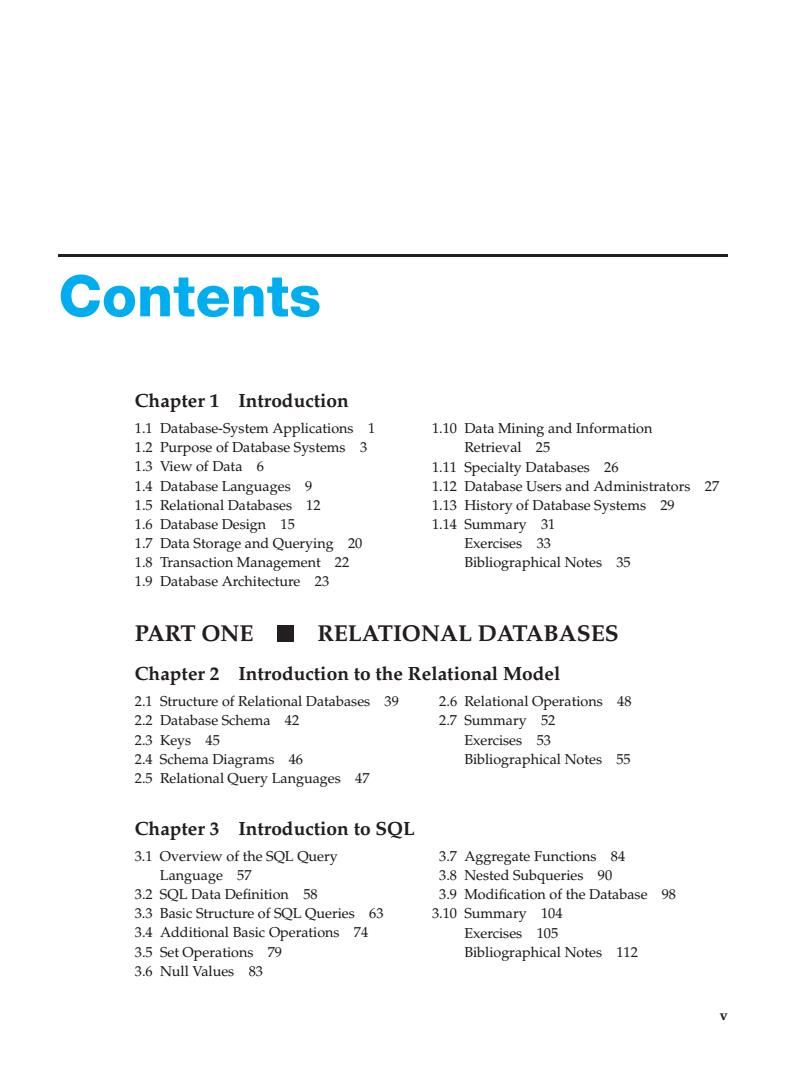
Contents Chapter 1 Introduction 1 3 1.11 Specialty Databases 26 1.4 Database Languages 9 1.12 Database Users and Administrators 27 1.5 Relational Databases 12 1.13 History of Database Systems 29 1.6 Database Design 15 1.14 Summary 31 1.7 Data Storage and Querying 20 Exercises 33 1.8 Transaction Management 22 Bibliographical Notes 35 1.9 Database Architecture 23 PART ONE RELATIONAL DATABASES Chapter 2 Introduction to the Relational Model 2.1 Structure of Relational Databases 39 2.6 Relational Operations 48 22 Database Schema 42 2.7 Summary 52 45 Exercises 2 ma Diagrams 46 Bibliographical Notes55 Relational Query Languages 47 Chapter 3 Introduction to SQL 3.1 Overview of the SQL Query 3.7 Aggregate Functions 84 Language 57 3.8 Nested Subqueries 90 3.2 SOL Data Definition 58 3.9 Modification of the Database 98 3.3 Basic Structure of SOL Oueries 63 3.10 Summary 104 3.4 Additional Basic Operations 74 cise 105 rations Bibliographical Notes 112 3.6 Null Values 83
Contents Chapter 1 Introduction 1.1 Database-System Applications 1 1.2 Purpose of Database Systems 3 1.3 View of Data 6 1.4 Database Languages 9 1.5 Relational Databases 12 1.6 Database Design 15 1.7 Data Storage and Querying 20 1.8 Transaction Management 22 1.9 Database Architecture 23 1.10 Data Mining and Information Retrieval 25 1.11 Specialty Databases 26 1.12 Database Users and Administrators 27 1.13 History of Database Systems 29 1.14 Summary 31 Exercises 33 Bibliographical Notes 35 PART ONE RELATIONAL DATABASES Chapter 2 Introduction to the Relational Model 2.1 Structure of Relational Databases 39 2.2 Database Schema 42 2.3 Keys 45 2.4 Schema Diagrams 46 2.5 Relational Query Languages 47 2.6 Relational Operations 48 2.7 Summary 52 Exercises 53 Bibliographical Notes 55 Chapter 3 Introduction to SQL 3.1 Overview of the SQL Query Language 57 3.2 SQL Data Definition 58 3.3 Basic Structure of SQL Queries 63 3.4 Additional Basic Operations 74 3.5 Set Operations 79 3.6 Null Values 83 3.7 Aggregate Functions 84 3.8 Nested Subqueries 90 3.9 Modification of the Database 98 3.10 Summary 104 Exercises 105 Bibliographical Notes 112 v
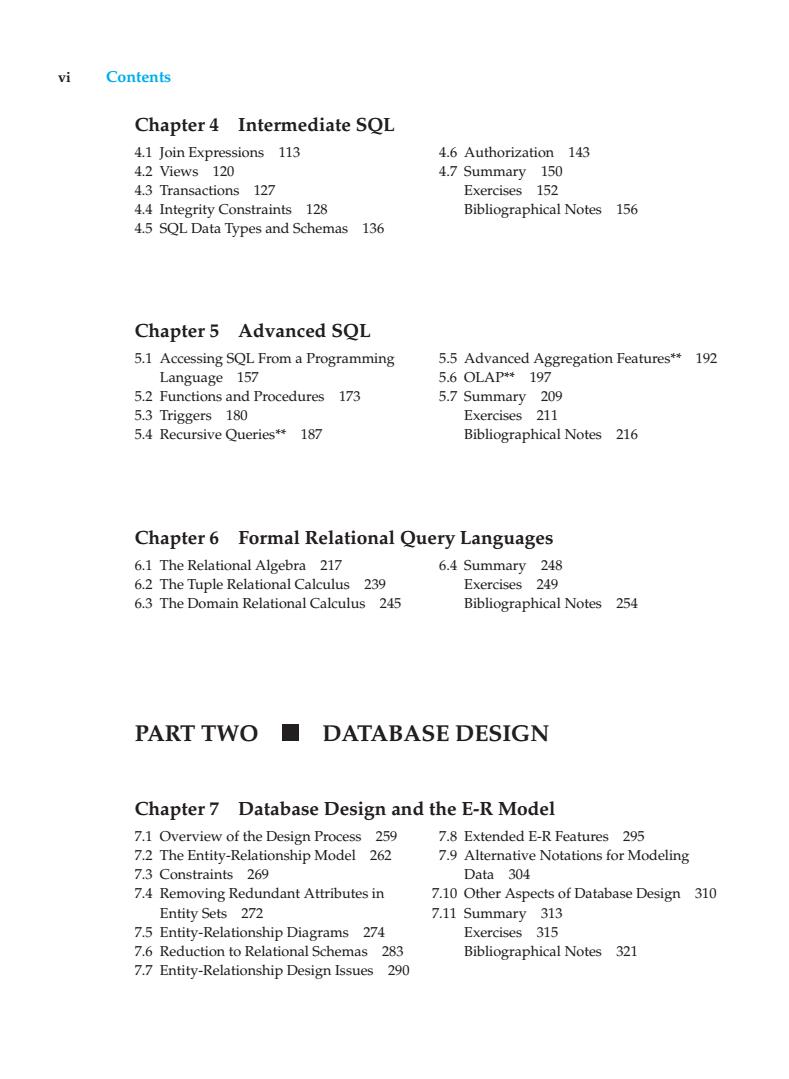
Contents Chapter 4 Intermediate SQL 4.1 Join Expressions 113 4.6 Authorization 143 42 Views 120 4.7 Summary 150 4.3 Transactions 127 Exercises 152 4.4 Integrity Constraints 128 Bibliographical Notes 156 45 SQL Data Types and Schemas 136 Chapter 5 Advanced SQI 5.1 Accessing SQL From a Programming d Procedures 173 Exercises 211 5.4 Recursive Queries*187 Bibliographical Notes 216 Chapter 6 Formal Relational Query Languages 6.1 The Relational Algebra 217 6.4 Summary 248 6.2 The Tuple Relational Calculus 239 Exercises 249 6.3 The Domain Relational Calculus 245 Bibliographical Notes 254 PART TWO DATABASE DESIGN Chapter 7 Database Design and the E-R Model 262 7.8 Extended E-R Features 295 7.9At ve Notations for Modeling 269 Data 304 7.10 Other Aspects of Database Design 310 Entity Sets 272 7.1I Summary 313 7.5 Entity-Relationship Diagrams 274 Exercises 315 7.6 Reduction to Relational Schemas 283 Bibliographical Notes 321 7.7 Entity-Relationship Design Issues 290
vi Contents Chapter 4 Intermediate SQL 4.1 Join Expressions 113 4.2 Views 120 4.3 Transactions 127 4.4 Integrity Constraints 128 4.5 SQL Data Types and Schemas 136 4.6 Authorization 143 4.7 Summary 150 Exercises 152 Bibliographical Notes 156 Chapter 5 Advanced SQL 5.1 Accessing SQL From a Programming Language 157 5.2 Functions and Procedures 173 5.3 Triggers 180 5.4 Recursive Queries** 187 5.5 Advanced Aggregation Features** 192 5.6 OLAP** 197 5.7 Summary 209 Exercises 211 Bibliographical Notes 216 Chapter 6 Formal Relational Query Languages 6.1 The Relational Algebra 217 6.2 The Tuple Relational Calculus 239 6.3 The Domain Relational Calculus 245 6.4 Summary 248 Exercises 249 Bibliographical Notes 254 PART TWO DATABASE DESIGN Chapter 7 Database Design and the E-R Model 7.1 Overview of the Design Process 259 7.2 The Entity-Relationship Model 262 7.3 Constraints 269 7.4 Removing Redundant Attributes in Entity Sets 272 7.5 Entity-Relationship Diagrams 274 7.6 Reduction to Relational Schemas 283 7.7 Entity-Relationship Design Issues 290 7.8 Extended E-R Features 295 7.9 Alternative Notations for Modeling Data 304 7.10 Other Aspects of Database Design 310 7.11 Summary 313 Exercises 315 Bibliographical Notes 321
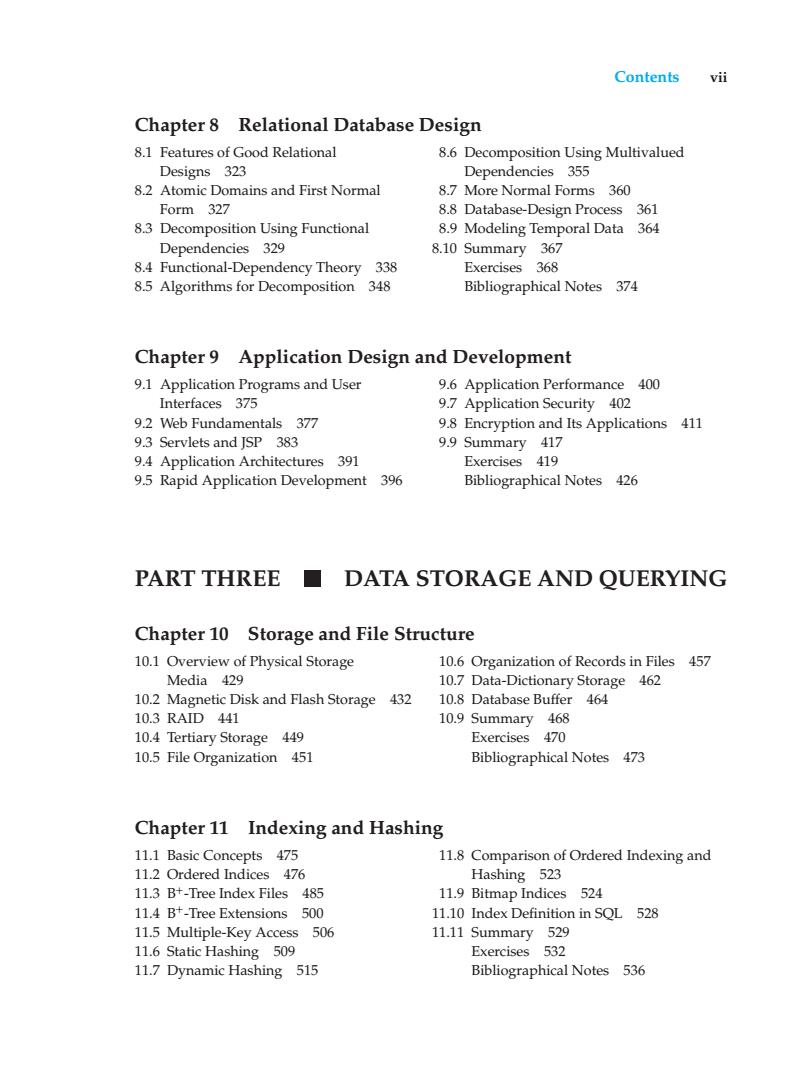
Contents vii Chapter 8 Relational Database Design 8.1 Features of Good Relational 86 Decomposition Using Multivalued igns 323 denci mains and First Normal 8 More Normal Forms 360 Form 327 8.8 Database-Design Process 36 8.3 Decomposition Using Functional 8.9 Modeling Temporal Data 364 Dependencies 329 8.10 Summary 367 8.4 Functional-Dependency Theory 338 Exercises 368 8.5 Algorithms for Decomposition 348 Bibliographical Notes 374 Chapter 9 Application Design and Development 9.1 Application Programs and User 9.6 Application Performance 400 Interfaces 375 9.7 Application Security 402 9.2 Web Fundamentals 377 9.8 Encryption and Its Applications 411 9.3 Servlets and JSP 383 9.9 Summary 417 9.4 Application Architectures 391 Exercises 419 95 Rapid Application Development 396 Bibliographical Notes 426 PART THREE DATA STORAGE AND QUERYING Chapter 10 Storage and File Structure 10.1 Overview of Physical Storage 10.6 Organization of Records in Files 457 Media 429 10.7 Data-Dictionary Storage 462 10.2 Magnetic Disk and Flash Storage 432 10.8 Database Buffer 464 10.3RAD441 10.9 Summary 468 10.4 Tertiary Storage 449 Exercises 470 10.5 File Organization 451 Bibliographical Notes 473 Chapter 11 Indexing and Hashing 11.1 Basic Concepts 475 11.8 Comparison of Ordered Indexing and 11.2 Ordered Indices 476 Hashing 523 11.3 B+-Tree Index Files 485 11.9 Bitmap Indices 524 11.4 B+-Tree Extensions 500 11.10 Index Definition in SQL 528 11.5 Multiple-Key Access 506 1111 Sur 529 11.6 Static Hashi 509 Exe 532 11.7 Dynamic Hashing 515 Bibliographical Notes 536
Contents vii Chapter 8 Relational Database Design 8.1 Features of Good Relational Designs 323 8.2 Atomic Domains and First Normal Form 327 8.3 Decomposition Using Functional Dependencies 329 8.4 Functional-Dependency Theory 338 8.5 Algorithms for Decomposition 348 8.6 Decomposition Using Multivalued Dependencies 355 8.7 More Normal Forms 360 8.8 Database-Design Process 361 8.9 Modeling Temporal Data 364 8.10 Summary 367 Exercises 368 Bibliographical Notes 374 Chapter 9 Application Design and Development 9.1 Application Programs and User Interfaces 375 9.2 Web Fundamentals 377 9.3 Servlets and JSP 383 9.4 Application Architectures 391 9.5 Rapid Application Development 396 9.6 Application Performance 400 9.7 Application Security 402 9.8 Encryption and Its Applications 411 9.9 Summary 417 Exercises 419 Bibliographical Notes 426 PART THREE DATA STORAGE AND QUERYING Chapter 10 Storage and File Structure 10.1 Overview of Physical Storage Media 429 10.2 Magnetic Disk and Flash Storage 432 10.3 RAID 441 10.4 Tertiary Storage 449 10.5 File Organization 451 10.6 Organization of Records in Files 457 10.7 Data-Dictionary Storage 462 10.8 Database Buffer 464 10.9 Summary 468 Exercises 470 Bibliographical Notes 473 Chapter 11 Indexing and Hashing 11.1 Basic Concepts 475 11.2 Ordered Indices 476 11.3 B+-Tree Index Files 485 11.4 B+-Tree Extensions 500 11.5 Multiple-Key Access 506 11.6 Static Hashing 509 11.7 Dynamic Hashing 515 11.8 Comparison of Ordered Indexing and Hashing 523 11.9 Bitmap Indices 524 11.10 Index Definition in SQL 528 11.11 Summary 529 Exercises 532 Bibliographical Notes 536
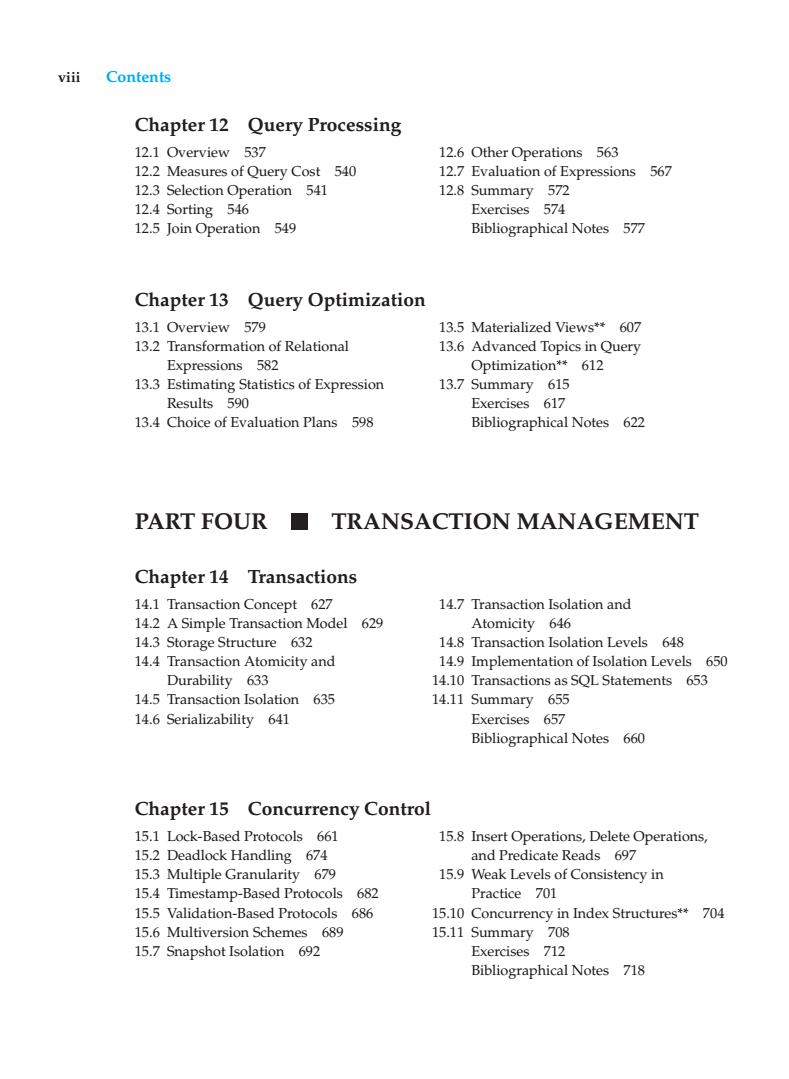
viii Contents Chapter 12 Query Processing 12.1 Overview 537 12.6 Other Operations 563 12.2 Measures of Query Cost 540 12 7 Evaluation of Exp essions 567 12.3 Selection Operation 541 12.8 Summary 572 12.4 Sorting 546 Exercises 574 12.5 Join Operation 549 Bibliographical Notes577 Chapter 13 Query Optimization 13.1 Overview 579 13.5 Materialized Views**607 13.2 Transformation of Relational 13.6 Advanced Topics in Query Expressions 582 13.3 Estimating Statistics of Expression 13.7S av615 Results 590 Exer 617 13.4 Choice of Evaluation Plans 598 Bibliographical Notes 622 PART FOUR■ TRANSACTION MANAGEMENT Chapter 14 Transactions 14.1 Transaction Concept 627 14.7 Transaction Isolation and 14.2 A Sir mple Tra n Model 629 Atomicity 646 14.3S Str 632 148T on Isolation Levels 648 14.4 T micity and 14.mplementation of i 650 63 1410 SQL Statements 14.5 on Isolation 635 1411 14.6 Serializability 641 Exercises 657 Bibliographical Notes 660 Chapter 15 Concurrency Control 15.8 Inse s,Delete Operations, g674 15.3 Multiple Granularity ate R 69 67 of Consistency in 15.4 Timestamp-Based Protocols 682 Practice 701 15.5 Validation-Based Protocols 686 15.10 Concurrency in Index Structures**704 15.6 Multiversion Schemes 689 15.11 Summary 708 15.7 Snapshot Isolation 692 Exercises 712 Bibliographical Notes 718
viii Contents Chapter 12 Query Processing 12.1 Overview 537 12.2 Measures of Query Cost 540 12.3 Selection Operation 541 12.4 Sorting 546 12.5 Join Operation 549 12.6 Other Operations 563 12.7 Evaluation of Expressions 567 12.8 Summary 572 Exercises 574 Bibliographical Notes 577 Chapter 13 Query Optimization 13.1 Overview 579 13.2 Transformation of Relational Expressions 582 13.3 Estimating Statistics of Expression Results 590 13.4 Choice of Evaluation Plans 598 13.5 Materialized Views** 607 13.6 Advanced Topics in Query Optimization** 612 13.7 Summary 615 Exercises 617 Bibliographical Notes 622 PART FOUR TRANSACTION MANAGEMENT Chapter 14 Transactions 14.1 Transaction Concept 627 14.2 A Simple Transaction Model 629 14.3 Storage Structure 632 14.4 Transaction Atomicity and Durability 633 14.5 Transaction Isolation 635 14.6 Serializability 641 14.7 Transaction Isolation and Atomicity 646 14.8 Transaction Isolation Levels 648 14.9 Implementation of Isolation Levels 650 14.10 Transactions as SQL Statements 653 14.11 Summary 655 Exercises 657 Bibliographical Notes 660 Chapter 15 Concurrency Control 15.1 Lock-Based Protocols 661 15.2 Deadlock Handling 674 15.3 Multiple Granularity 679 15.4 Timestamp-Based Protocols 682 15.5 Validation-Based Protocols 686 15.6 Multiversion Schemes 689 15.7 Snapshot Isolation 692 15.8 Insert Operations, Delete Operations, and Predicate Reads 697 15.9 Weak Levels of Consistency in Practice 701 15.10 Concurrency in Index Structures** 704 15.11 Summary 708 Exercises 712 Bibliographical Notes 718
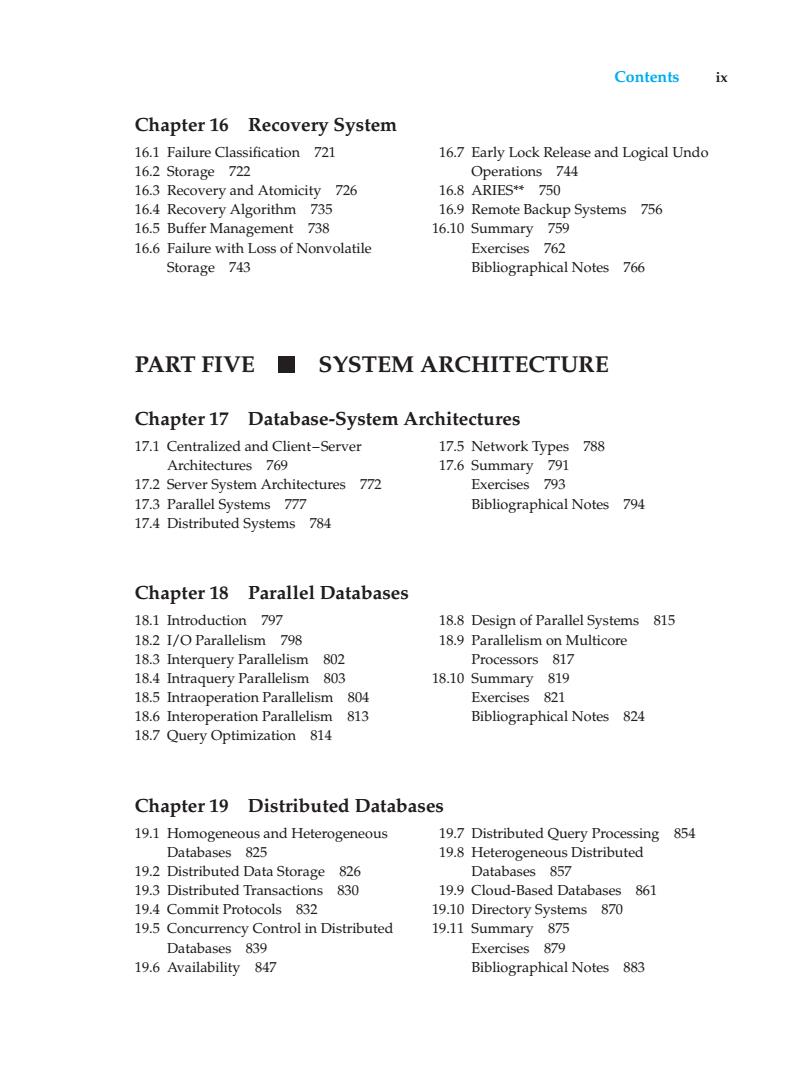
Contents ix Chapter 16 Recovery System 16.1 Failure Classification 721 16.7 Early Lock Release and Logical Undo 162 orage 16.3 Recovery and Atomicity 726 750 16.4 Recovery Algorithm73 16.9 Remote Backup Systems 756 16.5 Buffer Management 738 16.10 Summary 759 16.6 Failure with Loss of Nonvolatile Exercises 762 Storage 743 Bibliographical Notes 766 PART FIVE SYSTEM ARCHITECTURE Chapter 17 Database-System Architectures 17.1 Centralized and Client-Server 17.5 Network Types 788 ectures 7.6S 17.3 Parallel Systems 777 Bibliographical Notes 794 17.4 Distributed Systems 784 Chapter 18 Parallel Databases 181 Introduction 797 188 Desi 18.2 I/O Parallelism 798 18.9 Paralle Multicore 802 18.4 Intraquery Parallelism ǒU5 18.10 Summary 819 18.5 Intraoperation Parallelism 804 Exercises 821 18.6 Interoperation Parallelism 813 Bibliographical Notes 824 18.7 Ouery Optimization 814 Chapter 19 Distributed Databases 19.1 Homogeneous ndHaegaR 19.7 Distributed Query Pr ing 854 Databases 19.8 Heterogeneous Distributed 19.2 Distributed Data Storage 826 Databases 857 19.3 Distributed Transactions 830 19.9 Cloud-Based Databases 861 19.4 Commit Protocols 832 19.10 Directory Systems 870 19.5 Concurrency Control in Distributed 19.11 Summary 875 Databases 839 Exercises 879 19.6 Availability 847 Bibliographical Notes 883
Contents ix Chapter 16 Recovery System 16.1 Failure Classification 721 16.2 Storage 722 16.3 Recovery and Atomicity 726 16.4 Recovery Algorithm 735 16.5 Buffer Management 738 16.6 Failure with Loss of Nonvolatile Storage 743 16.7 Early Lock Release and Logical Undo Operations 744 16.8 ARIES** 750 16.9 Remote Backup Systems 756 16.10 Summary 759 Exercises 762 Bibliographical Notes 766 PART FIVE SYSTEM ARCHITECTURE Chapter 17 Database-System Architectures 17.1 Centralized and Client –Server Architectures 769 17.2 Server System Architectures 772 17.3 Parallel Systems 777 17.4 Distributed Systems 784 17.5 Network Types 788 17.6 Summary 791 Exercises 793 Bibliographical Notes 794 Chapter 18 Parallel Databases 18.1 Introduction 797 18.2 I/O Parallelism 798 18.3 Interquery Parallelism 802 18.4 Intraquery Parallelism 803 18.5 Intraoperation Parallelism 804 18.6 Interoperation Parallelism 813 18.7 Query Optimization 814 18.8 Design of Parallel Systems 815 18.9 Parallelism on Multicore Processors 817 18.10 Summary 819 Exercises 821 Bibliographical Notes 824 Chapter 19 Distributed Databases 19.1 Homogeneous and Heterogeneous Databases 825 19.2 Distributed Data Storage 826 19.3 Distributed Transactions 830 19.4 Commit Protocols 832 19.5 Concurrency Control in Distributed Databases 839 19.6 Availability 847 19.7 Distributed Query Processing 854 19.8 Heterogeneous Distributed Databases 857 19.9 Cloud-Based Databases 861 19.10 Directory Systems 870 19.11 Summary 875 Exercises 879 Bibliographical Notes 883
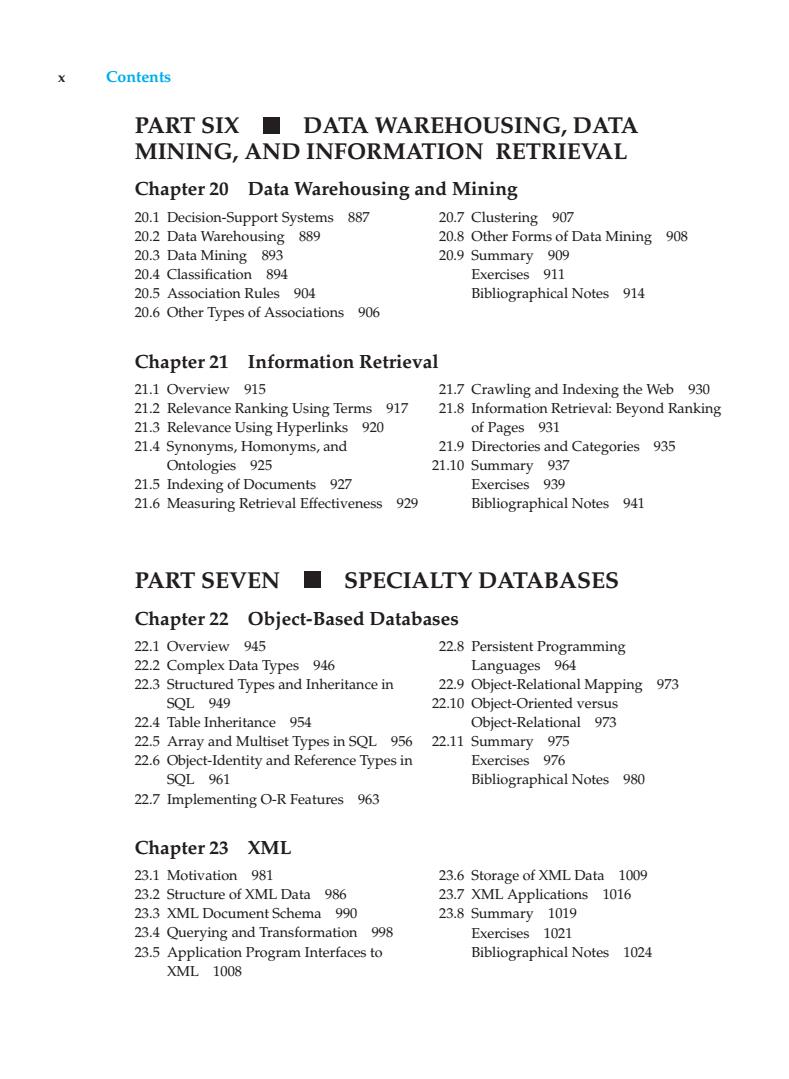
x Contents PART SIX DATA WAREHOUSING,DATA MINING,AND INFORMATION RETRIEVAL Chapter 20 Data Warehousing and Mining 2 rn 20.7 Clustering 907 202 Data Wareho 20.8 Other Forms of Data Mining 908 20.3 Data Mining 893 20.9 Summary 909 20.4 Classifica n894 911 20.5 Association Rule 904 Bibliographical Notes914 20.6 Other Types of Associations906 Chapter 21 Information Retrieval 21.1 Overview 915 21.7 Crawling and Indexing the Web 930 21.2 Relevance Ranking Using Terms 917 21.8 Information Retrieval:Beyond Ranking 21.3 Relevance Using Hyperlinks 920 of Pages 931 21.4 Synonyms,Homonyms,and 21.9 Directories and Categories 935 Ontologies 925 21 10 Summary 937 21.5 Indexing of Documents 927 Exercises 939 21.6 Measuring Retrieval Effectiveness 929 Bibliographical Notes 941 PART SEVEN SPECIALTY DATABASES Chapter 22 Object-Based Databases 22.1 Overview 945 22.8 Persistent Programming 22.2 Complex Data Types 946 Languages 964 22.3 Structured Types and Inheritance in 22.9 Object-Relational Mapping 973 S0L949 22.10 Object-Oriented versus 22.4 Table Inheritance 954 Object-Relational 973 22.5 Array and Multiset Types in SOL 956 22.11 Summary 975 22.6 Object-Identity and Reference Types in Exercises 976 S0L961 Bibliographical Notes 980 22.7 Implementing O-R Features 963 Chapter 23 XML 23.1 Motivation 981 23.6 Storage of XML Data 1009 23.2 Structure of XML Data 986 23.7 XML Applications 1016 23.3 XML Document Schema 990 23.8 Summary 1019 23.4 Querying and Transformation 998 Exercises 1021 23.5 Application Program Interfaces to Bibliographical Notes 1024 XML 1008
x Contents PART SIX DATA WAREHOUSING, DATA MINING, AND INFORMATION RETRIEVAL Chapter 20 Data Warehousing and Mining 20.1 Decision-Support Systems 887 20.2 Data Warehousing 889 20.3 Data Mining 893 20.4 Classification 894 20.5 Association Rules 904 20.6 Other Types of Associations 906 20.7 Clustering 907 20.8 Other Forms of Data Mining 908 20.9 Summary 909 Exercises 911 Bibliographical Notes 914 Chapter 21 Information Retrieval 21.1 Overview 915 21.2 Relevance Ranking Using Terms 917 21.3 Relevance Using Hyperlinks 920 21.4 Synonyms, Homonyms, and Ontologies 925 21.5 Indexing of Documents 927 21.6 Measuring Retrieval Effectiveness 929 21.7 Crawling and Indexing the Web 930 21.8 Information Retrieval: Beyond Ranking of Pages 931 21.9 Directories and Categories 935 21.10 Summary 937 Exercises 939 Bibliographical Notes 941 PART SEVEN SPECIALTY DATABASES Chapter 22 Object-Based Databases 22.1 Overview 945 22.2 Complex Data Types 946 22.3 Structured Types and Inheritance in SQL 949 22.4 Table Inheritance 954 22.5 Array and Multiset Types in SQL 956 22.6 Object-Identity and Reference Types in SQL 961 22.7 Implementing O-R Features 963 22.8 Persistent Programming Languages 964 22.9 Object-Relational Mapping 973 22.10 Object-Oriented versus Object-Relational 973 22.11 Summary 975 Exercises 976 Bibliographical Notes 980 Chapter 23 XML 23.1 Motivation 981 23.2 Structure of XML Data 986 23.3 XML Document Schema 990 23.4 Querying and Transformation 998 23.5 Application Program Interfaces to XML 1008 23.6 Storage of XML Data 1009 23.7 XML Applications 1016 23.8 Summary 1019 Exercises 1021 Bibliographical Notes 1024
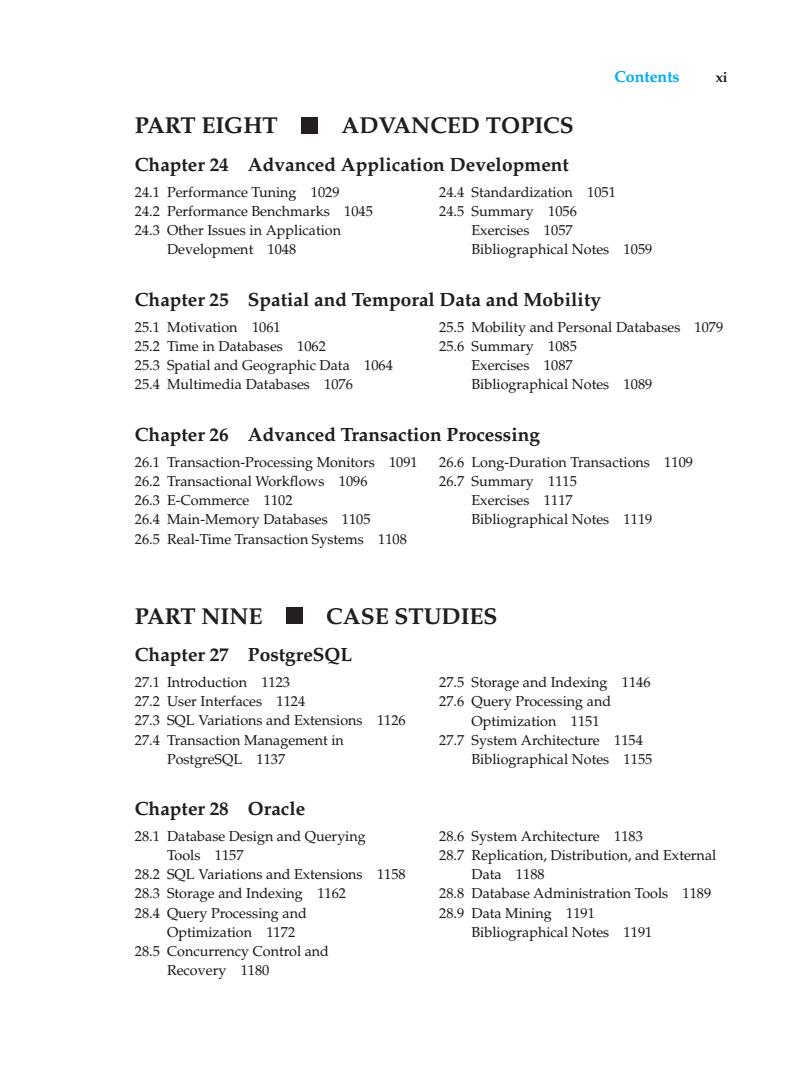
Contents xi PART EIGHT ADVANCED TOPICS Chapter 24 Advanced Application Development 24.1 Performance Tuning 1029 24.4 Standardization 1051 24.2 Performance Benchmarks 1045 24.5 Summary 1056 24.3 Other Issues in Application Exercises 1057 Development 1048 Bibliographical Notes 1059 Chapter 25 Spatial and Temporal Data and Mobility 25.1 Motivation 1061 25.5 Mobility and Personal Databases 1079 252 Time in D 25.3 tabases」 1062 Spatial and Geographic Data 1064 25.6 Summary 108 25.4 Multimedia Databases 1076 Bibliographical Notes 1089 Chapter 26 Advanced Transaction Processing 26.1 Transaction-Processing Monitors 1091 26.6 Long-Duration Transactions 1109 26.2 Transactional Workflows 1096 26.7Su mary 1115 26.3 E-Comn e1102 Exercises 1117 26 4 Main ory Databases 1105 Bibliographical Notes 1119 26.5 Real-Time Transaction Systems 1108 PART NINE CASE STUDIES Chapter 27 PostgreSQL 27.1 Introduction 1123 27.5 Storage and Indexing 1146 27.2 User Interfaces 1124 27.6 Query Processing and 27.3 SOL Variations and Extensions 1126 Optin mization 1151 27.4 tion Man gement in 27.7 n Arch 1154 Notes 1155 Chapter 28 Oracle 28.1 Database Design and Querying 28.6 System Architecture 1183 Tools 1157 28.7 Replication,Distribution,and External 28.2 SQL Variations and Extensions 1158 Data 1188 28.3 Storage and Indexing 1162 28.8 Database Administration Tools 1189 28.4 Query Processing and 28.9 Data Mining 1191 mization 1172 Bibliograp hical Notes 1191 ncurren Control and Recovery 1180
Contents xi PART EIGHT ADVANCED TOPICS Chapter 24 Advanced Application Development 24.1 Performance Tuning 1029 24.2 Performance Benchmarks 1045 24.3 Other Issues in Application Development 1048 24.4 Standardization 1051 24.5 Summary 1056 Exercises 1057 Bibliographical Notes 1059 Chapter 25 Spatial and Temporal Data and Mobility 25.1 Motivation 1061 25.2 Time in Databases 1062 25.3 Spatial and Geographic Data 1064 25.4 Multimedia Databases 1076 25.5 Mobility and Personal Databases 1079 25.6 Summary 1085 Exercises 1087 Bibliographical Notes 1089 Chapter 26 Advanced Transaction Processing 26.1 Transaction-Processing Monitors 1091 26.2 Transactional Workflows 1096 26.3 E-Commerce 1102 26.4 Main-Memory Databases 1105 26.5 Real-Time Transaction Systems 1108 26.6 Long-Duration Transactions 1109 26.7 Summary 1115 Exercises 1117 Bibliographical Notes 1119 PART NINE CASE STUDIES Chapter 27 PostgreSQL 27.1 Introduction 1123 27.2 User Interfaces 1124 27.3 SQL Variations and Extensions 1126 27.4 Transaction Management in PostgreSQL 1137 27.5 Storage and Indexing 1146 27.6 Query Processing and Optimization 1151 27.7 System Architecture 1154 Bibliographical Notes 1155 Chapter 28 Oracle 28.1 Database Design and Querying Tools 1157 28.2 SQL Variations and Extensions 1158 28.3 Storage and Indexing 1162 28.4 Query Processing and Optimization 1172 28.5 Concurrency Control and Recovery 1180 28.6 System Architecture 1183 28.7 Replication, Distribution, and External Data 1188 28.8 Database Administration Tools 1189 28.9 Data Mining 1191 Bibliographical Notes 1191
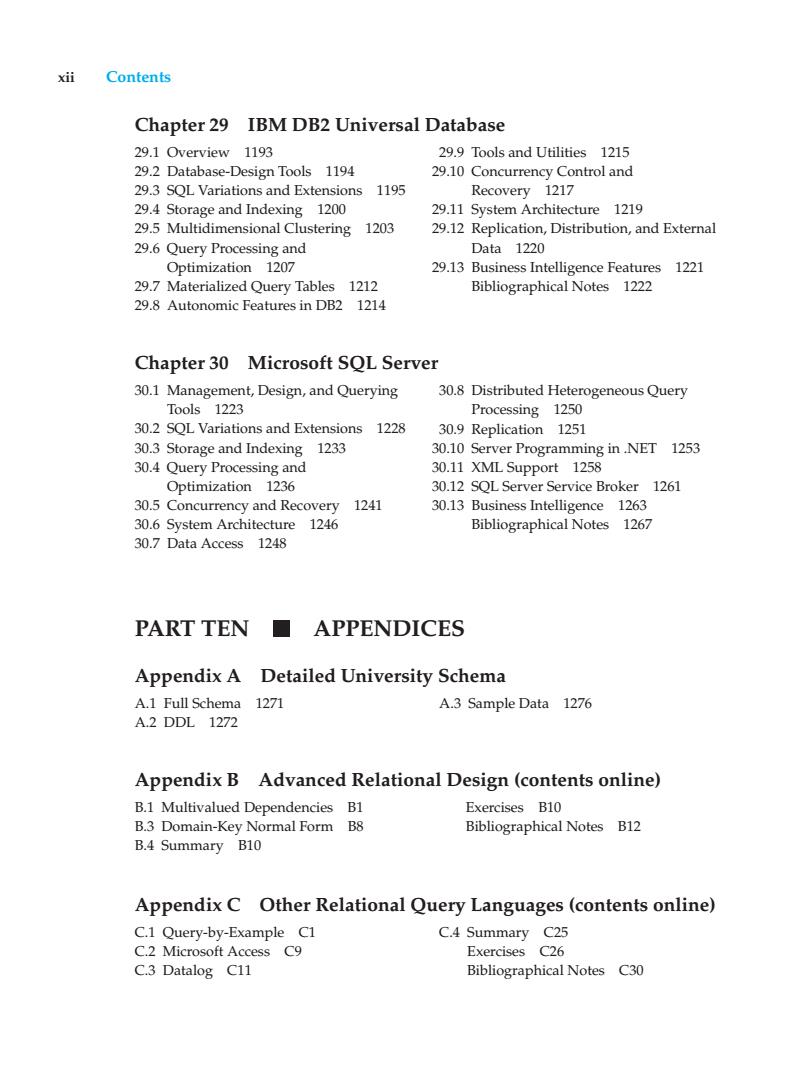
xii Contents Chapter 29 IBM DB2 Universal Database 29.1 Overview 1193 299 Tools and Utilities 1215 29.2 Database-Design Tools 1194 29.10 Concurrency Control and 29.3 SOL Variations and Extensions 1195 Recovery 1217 29.4 Storage and Indexing 1200 29.11 System Architecture 1219 29.5 Multidin onal Clustering 1203 29.12 Replication,Distribution,and External 1220 on 29.7 Materialized Query Tables 121 29.8 Autonomic Features in DB2 1214 Chapter 30 Microsoft SOL Server 30.1 Management,Design,and Querying 30.8 Distributed Heterogeneous Query Tools 1223 Processing 1250 30.2 SQL Variations and Extensions 1228 30.9 Replication 1251 30.3 Storage and Indexing 1233 o 30.10 Server Programming in.NET 1253 30.40 30.11 XML S ppo 1258 Optimiz 、1226 3012c0IS vice Broker 1261 30.5 and Recc 1241 206 30.13 Business Intellig 163 e1246 Bibliographical Notes 124 PART TEN■ APPENDICES Appendix A Detailed University Schema A.1 Full Schema 1271 A.3 Sample Data 1276 A.2 DDL 1272 Appendix B Advanced Relational Design(contents online) Exercises B10 B3 Doma orn B8 Bib iographical Notes B12 B.4 Summary B10 Appendix C Other Relational Query Languages(contents online) C.1 Query-by-Example C1 C.4 Summary C25 C.2 Microsoft Access C9 Exercises C26 C.3 Datalog C11 Bibliographical Notes C30
xii Contents Chapter 29 IBM DB2 Universal Database 29.1 Overview 1193 29.2 Database-Design Tools 1194 29.3 SQL Variations and Extensions 1195 29.4 Storage and Indexing 1200 29.5 Multidimensional Clustering 1203 29.6 Query Processing and Optimization 1207 29.7 Materialized Query Tables 1212 29.8 Autonomic Features in DB2 1214 29.9 Tools and Utilities 1215 29.10 Concurrency Control and Recovery 1217 29.11 System Architecture 1219 29.12 Replication, Distribution, and External Data 1220 29.13 Business Intelligence Features 1221 Bibliographical Notes 1222 Chapter 30 Microsoft SQL Server 30.1 Management, Design, and Querying Tools 1223 30.2 SQL Variations and Extensions 1228 30.3 Storage and Indexing 1233 30.4 Query Processing and Optimization 1236 30.5 Concurrency and Recovery 1241 30.6 System Architecture 1246 30.7 Data Access 1248 30.8 Distributed Heterogeneous Query Processing 1250 30.9 Replication 1251 30.10 Server Programming in .NET 1253 30.11 XML Support 1258 30.12 SQL Server Service Broker 1261 30.13 Business Intelligence 1263 Bibliographical Notes 1267 PART TEN APPENDICES Appendix A Detailed University Schema A.1 Full Schema 1271 A.2 DDL 1272 A.3 Sample Data 1276 Appendix B Advanced Relational Design (contents online) B.1 Multivalued Dependencies B1 B.3 Domain-Key Normal Form B8 B.4 Summary B10 Exercises B10 Bibliographical Notes B12 Appendix C Other Relational Query Languages (contents online) C.1 Query-by-Example C1 C.2 Microsoft Access C9 C.3 Datalog C11 C.4 Summary C25 Exercises C26 Bibliographical Notes C30
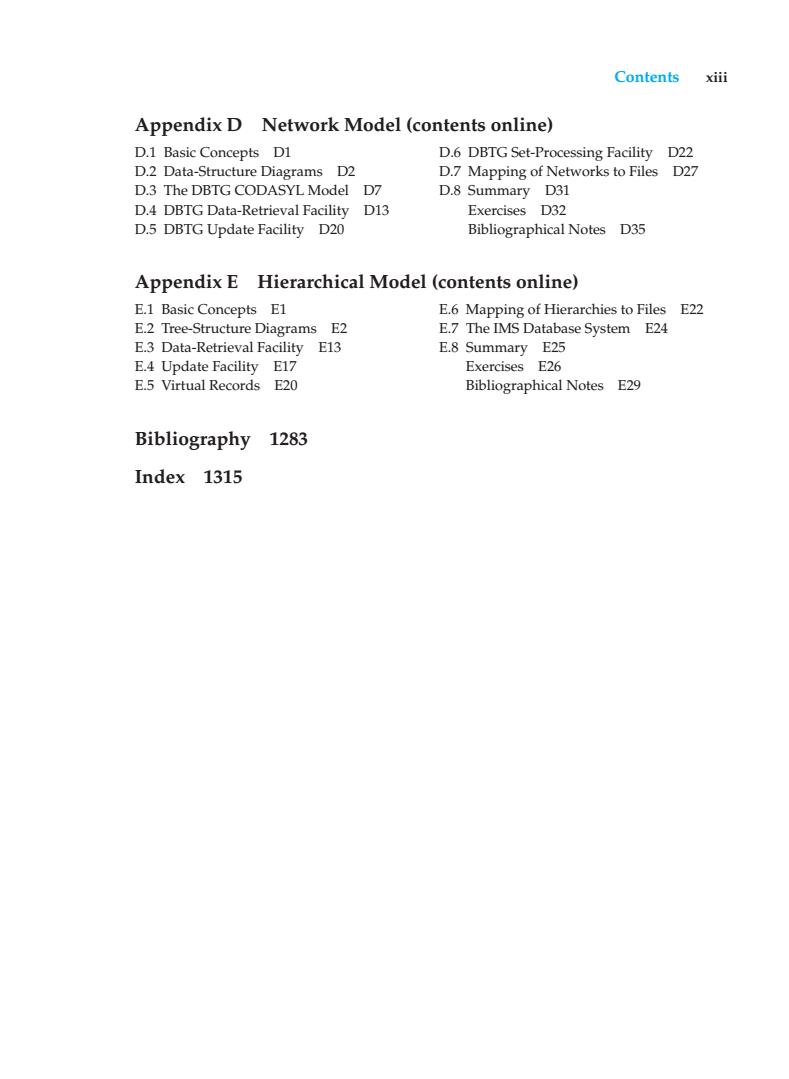
Contents xiii Appendix D Network Model(contents online) D.1 Basic Concepts D1 D.2 Da D.6 DBTG Set-Processing Facility D2 D.7 Mapping of tworks to Files D.8 Summary D31 D.4 DBTG Data-Retrieval Facility D13 Exercises D32 D.5 DBTG Update Facility D20 Bibliographical Notes D35 Appendix E Hierarchical Model (contents online) E22 E.77 E.8 Summary E25 E.4 Update Facility E17 Exercises E26 E.5 Virtual Records E20 Bibliographical Notes E29 Bibliography 1283 Index 1315
Contents xiii Appendix D Network Model (contents online) D.1 Basic Concepts D1 D.2 Data-Structure Diagrams D2 D.3 The DBTG CODASYL Model D7 D.4 DBTG Data-Retrieval Facility D13 D.5 DBTG Update Facility D20 D.6 DBTG Set-Processing Facility D22 D.7 Mapping of Networks to Files D27 D.8 Summary D31 Exercises D32 Bibliographical Notes D35 Appendix E Hierarchical Model (contents online) E.1 Basic Concepts E1 E.2 Tree-Structure Diagrams E2 E.3 Data-Retrieval Facility E13 E.4 Update Facility E17 E.5 Virtual Records E20 E.6 Mapping of Hierarchies to Files E22 E.7 The IMS Database System E24 E.8 Summary E25 Exercises E26 Bibliographical Notes E29 Bibliography 1283 Index 1315